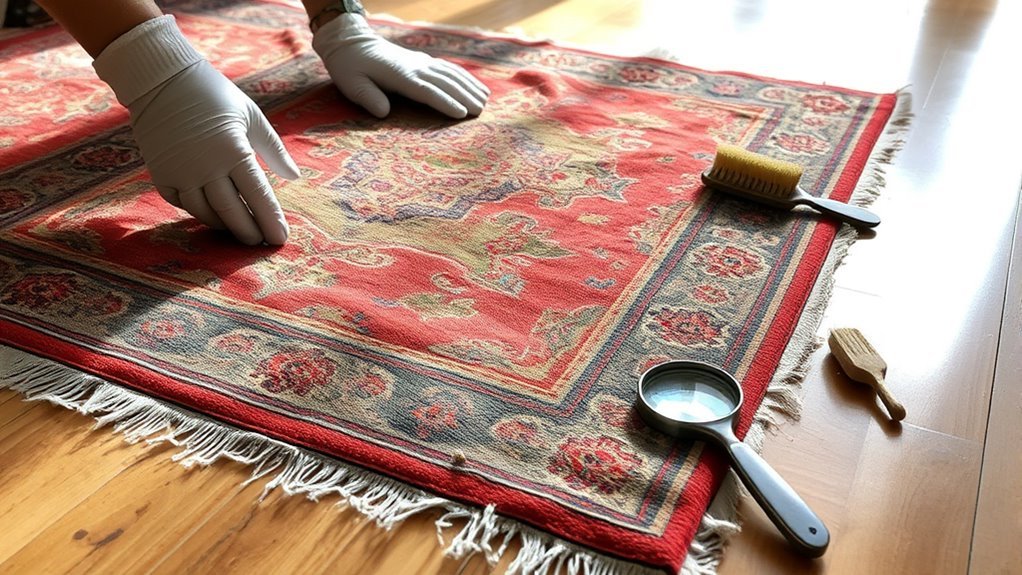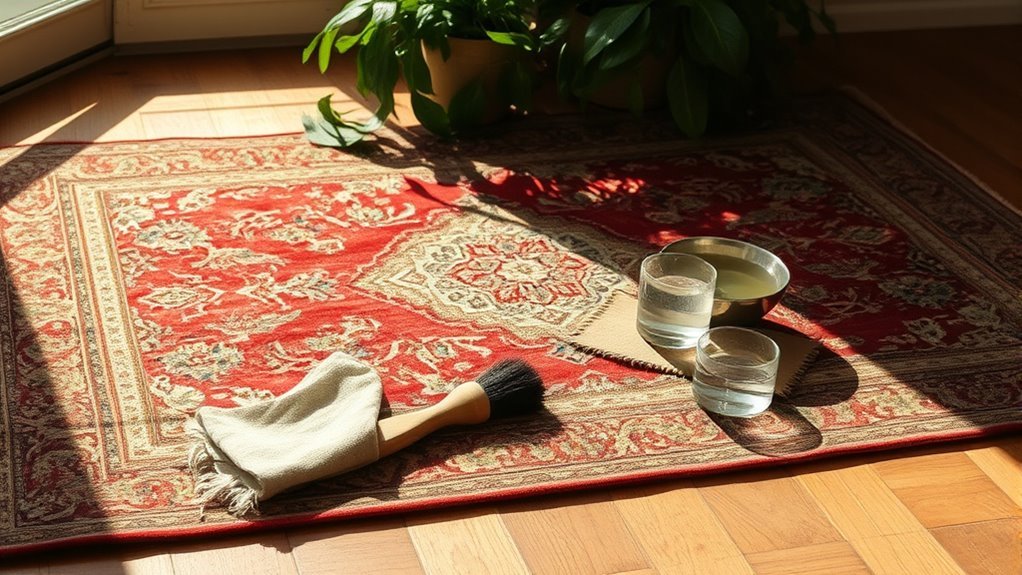Tips for Cleaning and Restoring Vintage Rugs
When cleaning your vintage rug, first check its condition—look for wear, stains, and fiber type. Use cold water and mild, pH-neutral detergent, testing solutions on a hidden spot. Gently blot stains without rubbing, and air dry it away from sunlight. Repair worn areas with matching threads or consider a professional if damage is extensive. Rotate and vacuum gently to prevent wear. Keep these basics in mind, and you’ll find helpful ways to preserve your rug’s beauty longer.
Assessing the Condition of Your Vintage Rug

Before you begin cleaning or restoring your vintage rug, you’ll need to carefully assess its condition. Start by determining the rug age, as older rugs may require more delicate handling or professional advice. Examine the fiber types—wool, silk, cotton, or synthetic blends—as each reacts differently to cleaning methods. Feel the texture and look for signs of wear, such as fraying edges, thinning pile, or color fading. Check for stains, moth damage, or any loose threads that could worsen if not treated properly. Knowing these details gives you the freedom to choose the right approach without risking damage. This initial assessment guarantees your vintage rug retains its charm and integrity while you bring it back to life.
Gentle Cleaning Techniques for Delicate Fibers
Three gentle cleaning techniques are essential when dealing with delicate fibers like silk or fine wool in your vintage rug. Since different fiber types react uniquely, choosing the right cleaning solutions is key to preserving your rug’s beauty and integrity. Here’s how you can care for those fragile fibers without restricting your freedom to enjoy your space:
- Test cleaning solutions on a small, hidden area first
- Use cold water to prevent fiber shrinkage or color bleeding
- Apply a mild, pH-neutral detergent formulated for delicate fabrics
- Gently blot stains with a soft cloth instead of rubbing
- Air-dry the rug flat away from direct sunlight to avoid fading
Following these steps lets you refresh your vintage rug safely, respecting both its age and your desire to maintain its charm.
Removing Stains Without Damaging the Rug

Although vintage rugs demand careful handling, you can effectively remove stains without causing damage by using the right methods. Start by blotting the stain gently with a clean, white cloth—never rub, as this can spread the stain and harm delicate fibers. Use a mild, pH-neutral cleaning solution designed for carpet care to treat the area. Test it first on a hidden spot to verify it won’t fade colors or weaken the fabric. For tougher stains, a mixture of water and white vinegar can work wonders without harsh chemicals. Always work from the rug’s edge toward the center to avoid spreading. Quick action and patience are key to successful stain removal, preserving your rug’s beauty while giving you the freedom to enjoy it worry-free.
Repairing and Restoring Worn or Damaged Areas
When you notice worn or damaged areas on your vintage rug, addressing them promptly can prevent further deterioration and preserve its charm. You want your rug to stay vibrant and strong, so consider these steps:
- Assess the damage carefully to determine the best patching techniques.
- Choose threads and fabrics that match the original colors for seamless color matching.
- Remove any loose fibers before starting repairs.
- Use a needle and thread or professional tools to reinforce weak spots.
- If the damage is extensive, consult a rug restoration expert for advanced repairs.
Preventative Care to Maintain Longevity

After repairing worn or damaged areas, you’ll want to focus on preventative care to keep your vintage rug looking its best for years to come. Regular seasonal maintenance is key—rotate your rug every few months to guarantee even wear and avoid prolonged exposure to sunlight, which can fade colors. Vacuum gently to remove dirt without damaging fibers. When storing your rug, follow proper storage guidelines: clean it thoroughly, roll it (never fold), and wrap it in breathable fabric to prevent moisture buildup and pests. Store in a cool, dry place away from direct sunlight. By committing to these simple steps, you’ll preserve your rug’s beauty and freedom from costly repairs, letting it remain a vibrant part of your space without holding you back.
Frequently Asked Questions
How Can I Identify the Origin and Age of My Vintage Rug?
To identify your vintage rug’s origin and age, you’ll want to examine the rug patterns closely—different regions have unique motifs and designs. Check the material types too; wool, silk, or cotton can hint at where and when it was made. Don’t hesitate to research or consult experts who appreciate your freedom to explore. This way, you’ll connect with your rug’s story and heritage without feeling boxed in.
What Types of Vintage Rugs Are Most Valuable?
When you’re hunting for the most valuable vintage rugs, focus on those featuring classic Persian patterns—they’re timeless and highly sought after. Rugs crafted from antique materials, like hand-spun wool or natural dyes, usually fetch higher prices because of their authenticity and craftsmanship. If you want freedom in your collection, choose pieces that tell a story and showcase unique artistry. These rugs aren’t just decor; they’re expressions of culture and history you can truly own.
Can Vintage Rugs Be Safely Used in High-Traffic Areas?
Imagine you’ve placed a delicate Persian vintage rug in your busy hallway. Can it handle that? Vintage rug durability varies, so you’ll want to contemplate high traffic maintenance carefully. While some rugs can endure daily footfall, others may wear quickly. You can still enjoy freedom in your home by rotating rugs, using protective pads, or limiting exposure to heavy use—preserving beauty without sacrificing your lifestyle’s flow.
How Do Humidity and Temperature Affect Vintage Rugs?
You’ll want to keep an eye on humidity effects because too much moisture can lead to mold or mildew, damaging your vintage rug’s fibers. On the flip side, temperature variations can cause the materials to expand and contract, which might weaken the rug over time. To preserve your rug’s freedom to shine, try to maintain a stable environment—avoid extreme humidity or temperature swings—and you’ll keep it looking great for years to come.
Are There Professional Services Recommended for Vintage Rug Appraisal?
If you’re looking for a vintage rug valuation, it’s smart to seek out an expert appraisal. Professionals specialize in evaluating your rug’s age, materials, and craftsmanship, giving you an accurate value. You don’t have to navigate this alone—these experts offer the freedom to understand your rug’s true worth, whether for insurance, sale, or personal knowledge. Look for certified appraisers or reputable antique dealers who focus on vintage rugs.






